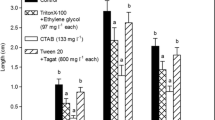Abstract
The present paper reports our attempts to determine whether the inclusion of 0.0014 mM Zn++ within a hydroponic culture medium affects the ability of 12-day-old Zea mays, cv. ‘SS-522’ to take-up [3H]-aflatoxin B1. Data from the corollary experiment, i.e., whether inclusion of aflatoxin affects the ability of Zea mays, cvs. ‘Truckers White’, ‘X-Sweet’ and ‘Merit’ to take-up 65ZnCl2 are presented also. This report is a preliminary to one regarding an in-progress analysis of whether pollutant levels of Zn++ affect aflatoxin uptake and distribution. In the absence of irrigating seedlings, which were grown in Perlite containing 65ZnCl2, with a solution containing mixed aflatoxins, the stem contained the greatest amount of label with root plus seed the next highest and the leaf the least for each of the cvs. In contrast, when the seedlings were irrigated with a solution containing mixed aflatoxins, the root plus seed contained either an amount nearly identical to (cv. ‘Truckers White’) or in excess of that within the stem (cvs. ‘X-Sweet’ and ‘Merit’). Calculation of the percentages of aflatoxin-induced diminutions in leaf, stem and root label suggested that the aflatoxins interfered with the translocation of 65ZnCl2 from the root to the stem and leaf, at least for cvs ‘X-Sweet’ and ‘Merit’. When 0.0014mM Zn++ as ZnSO4 was added to an incubation medium in which 12-day-old seedlings were suspended and plant growth assessed over 72 hours, a 15% increase (significant at 0.05 level) in seedling height over that of Zn++-deficient plants was observed. No differences in [3H]-aflatoxin B1 uptake were noted between those seedlings which were grown in either Zn++-containing or lacking media. Less than one % of the[3H]-aflatoxin B1 which was taken-up was recovered within chloroform extracts of the seedlings. The distributions of radioactivity from [3H]-aflatoxin B1 for leaf, stem, seed and root were 0, 57, 26 and 19% and 0, 26, 58 and 18% for Zn++-containing and -lacking media, ‘respectively’.
Similar content being viewed by others
References
Baker, A. J. M., 1978. Ecophysiological aspects of zinc tolerance in Silene maritima With. New Phytol. 80:635–642.
Brown, G. N. & Taylor, F. G., 1966. 65Zinc distribution and radiosensitivity of growth and 65Zn uptake in red oak seedlings. Rad. Bot. 8: 519–524.
Devlin, R. M., 1969. Plant Physiology Van Nostrand Reinhold Company, New York.
Hewitt, E. J., 1958. The role of mineral elements in the activity of plant enzyme systems. In: Handbuck der Pflanzen Physiologie (ed.) W. Ruhland Springer, Berlin. Volume IV, pg. 427–481.
Liener, I. E., 1980. Toxic Constituents of Plant Foodstuffs. Academic Press, N. Y.
Maggon, K. K., Gupta, S. K. & Venkitasubramanian, T. A., 1977. Biosynthesis of aflatoxins. Bacteriol. Reviews 41: 822–855.
Mathys, W., 1973. Vergleichende Untersuchungen der Zink-aufnahme van resistenten und sensitiven Populationen van Agrostis tenuis Sibth. Flora 162: 492–499.
Mathys, W., 1980. Zinc tolerance by plants. In: Zinc in the Environment. Part II. Health Effects. ed. J. O. Nriagu, John Wiley & Sons, Inc., N.Y.
Mendenhall, W. & Ott, L., 1972. Understanding Statistics, Duxbury Press, Belmont, CA.
Mertz, D., Lee, D., Zuber, M. & Lillehoj, E., 1980. Uptake and metabolism of aflatoxin by Zea mays. J. Agr. Food Chem. 28: 963–966.
McMillan, W. W., Wilson, D. M. & Widstrom, N. W., 1978. Insect damage, Aspergillus flavus ear mold, and mold corn fields contamination in South Georgia in 1977. J. Expt. Qual. 7: 564–566.
Turner, R. G., 1970. The subcellular distribution of zinc and copper within the roots of metal-tolerant clones of Agrostis tenuis Sibth. New Phytol. 69: 725–731.
Turner, R. G. & Marshall, C., 1971. The accumulation of 65Zn by root homogenates of zinc-tolerant and non-tolerant clones of Agrostis tenuis Sibth. New Phytol. 70: 539–545.
Vallee, B. L. & Wacker, W. E. C., 1970. Metalloproteins. In: The Proteins 5 (ed.) H. Neurath, N.Y.
Wiklander, L. & Vahtras, K., 1977. Solubility and uptake of heavy metals from a Swedish soil. Geoderma 19: 123–124.
Author information
Authors and Affiliations
Rights and permissions
About this article
Cite this article
Llewellyn, G.C., Reynolds, J.D., Hurst, L. et al. Uptake of Zn++ and aflatoxin from perlite and liquid culture by Zea mays seedlings. Mycopathologia 77, 111–116 (1982). https://doi.org/10.1007/BF00437393
Issue Date:
DOI: https://doi.org/10.1007/BF00437393




